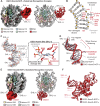Contributing factors to the oxidation-induced mutational landscape in human cells
- PMID: 39715760
- PMCID: PMC11666792
- DOI: 10.1038/s41467-024-55497-z
Contributing factors to the oxidation-induced mutational landscape in human cells
Abstract
8-oxoguanine (8-oxoG) is a common oxidative DNA lesion that causes G > T substitutions. Determinants of local and regional differences in 8-oxoG-induced mutability across genomes are currently unknown. Here, we show DNA oxidation induces G > T substitutions and insertion/deletion (INDEL) mutations in human cells and cancers. Potassium bromate (KBrO3)-induced 8-oxoGs occur with similar sequence preferences as their derived substitutions, indicating that the reactivity of specific oxidants dictates mutation sequence specificity. While 8-oxoG occurs uniformly across chromatin, 8-oxoG-induced mutations are elevated in compact genomic regions, within nucleosomes, and at inward facing guanines within strongly positioned nucleosomes. Cryo-electron microscopy structures of OGG1-nucleosome complexes indicate that these effects originate from OGG1's ability to flip outward positioned 8-oxoG lesions into the catalytic pocket while inward facing lesions are occluded by the histone octamer. Mutation spectra from human cells with DNA repair deficiencies reveals contributions of a DNA repair network limiting 8-oxoG mutagenesis, where OGG1- and MUTYH-mediated base excision repair is supplemented by the replication-associated factors Pol η and HMCES. Transcriptional asymmetry of KBrO3-induced mutations in OGG1- and Pol η-deficient cells also demonstrates transcription-coupled repair can prevent 8-oxoG-induced mutation. Thus, oxidant chemistry, chromatin structures, and DNA repair processes combine to dictate the oxidative mutational landscape in human genomes.
© 2024. The Author(s).
Conflict of interest statement
Competing interests: The authors declare no competing interests.
Figures







References
Publication types
MeSH terms
Substances
Associated data
- SRA/PRJNA940340
- Actions
- Actions
- Actions
- Actions
- Actions
Grants and funding
- R35GM128562/U.S. Department of Health & Human Services | NIH | National Institute of General Medical Sciences (NIGMS)
- R35 GM128562/GM/NIGMS NIH HHS/United States
- F32GM140718/U.S. Department of Health & Human Services | NIH | National Institute of General Medical Sciences (NIGMS)
- F32 GM140718/GM/NIGMS NIH HHS/United States
- F32 GM136096/GM/NIGMS NIH HHS/United States
- R00ES034058/U.S. Department of Health & Human Services | NIH | National Institute of Environmental Health Sciences (NIEHS)
- R01ES032814/U.S. Department of Health & Human Services | NIH | National Institute of Environmental Health Sciences (NIEHS)
- R00 ES034058/ES/NIEHS NIH HHS/United States
- R01CA269784/U.S. Department of Health & Human Services | NIH | National Cancer Institute (NCI)
- K99 ES034058/ES/NIEHS NIH HHS/United States
- R01ES030575/U.S. Department of Health & Human Services | NIH | National Institute of Environmental Health Sciences (NIEHS)
- R01 ES030575/ES/NIEHS NIH HHS/United States
- F32GM136096/U.S. Department of Health & Human Services | NIH | National Institute of General Medical Sciences (NIGMS)
- R01 ES032814/ES/NIEHS NIH HHS/United States
- R01 CA269784/CA/NCI NIH HHS/United States
LinkOut - more resources
Full Text Sources
Molecular Biology Databases
Research Materials

